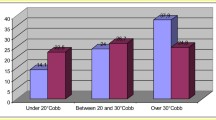Abstract
In a prospective study, 23 consecutive girls with Rett syndrome and neuromuscular scoliosis were evaluated for functioning at a long-term follow-up. The patients had mostly improved, which was confirmed by their parents. Rett syndrome is associated with neuromuscular scoliosis and has a typically long C-shaped thoracolumbar kyphoscoliosis. Prospective long-term follow-up studies related to these patients’ total situation are sparse. Most studies focus on the Cobb angle of the scoliosis, whereas parents are mainly concerned about the girls’ continued functioning. Twenty-three patients with Rett syndrome and neuromuscular scoliosis were evaluated preoperatively from 1993 to 2002. At follow-up, 19 patients remained in the study. Three patients died (not due to surgery), and one patient could not participate because it was too far to travel. Mean follow-up time was 74 months (range 49–99 months). The assessments comprised the sitting balance, seating supports in wheelchair, weight distribution, time used for rest, care given, and angle of scoliosis. Follow-up questionnaires and two-open-ended questions about the positive and negative effects of surgery were sent to parents. Sitting balance, number of seating supports in wheelchair, weight distribution, time used for rest, and the Cobb angle had all improved after surgery. The parents assessed improvement in seating position, daily activities, time used for rest, and cosmetic appearance. We can conclude that the stabilized spine resulted in sufficient strength to keep the body upright with the possibility of looking around at the surroundings more easily. The girls got better seating position with less need for seating adaptations in the wheelchair and with reduced time needed for resting during the day. Finally we can conclude that the indication for surgery is to get a better posture which lead to less risk of pressure sores, and that un upright position lead to better possibility to easily breath with fewer episodes of pneumonia and a better general health as result. The evidence of positive surgical effects for girls with Rett syndrome is of great importance in indication for surgery in the decision-making process.

Similar content being viewed by others
Notes
In the Aaro anterior system the rod is replaced by two cm thick six cm wideband. It passes vertebral plates fixated to the vertebrae by two screws. The correction is by compression.
References
Gillings D, Koch G (1991) The application of the principle of intention-to-treat to the analysis of clinical trials. Drug Inf J 25:411–424
Harrison DJ, Webb PJ (1990) Scoliosis in the Rett syndrome: natural history and treatment. Brain Dev 12(1):154–156
Huang T-J, Lubicky JP, Hammerberg KW (1994) Scoliosis in Rett Syndrome. Orthopaedic review. December 1994, pp 931–937
Kerr AM, Webb P, Prescott RJ, Milne Y (2003) Results of surgery for scoliosis in Rett syndrome. J Child Neurol 18(10):703–708
Larsson E-L, Aaro S, Ahlinder P, Öberg B (1998) Preoperative evaluation of activity and function in patients with paralytic scoliosis. Eur Spine J 7:294–301
Larsson E-L, Aaro S, Öberg B (1999) Activities and functional assessment 1 year after spinal fusion for paralytic scoliosis. Eur Spine J 8:100–109
Larsson E-LC, Aaro SI, Normelli HC, Öberg BE (2005) Long-term follow-up of functioning after spinal surgery in patients with paralytic scoliosis. SPINE 30(19):2145–2152
Larsson G, Lindström B, Engerström IW (2005) Rett syndrome from a family perspective: the Swedish Rett Center survey. Brain Dev 27(Suppl 1):14–19
Lidström J, Stokland E, Hagberg B (1994) Scoliosis in Rett syndrome. Clinical and biological aspects. Spine 19(14):1632–1635
Meguro K, Ueda M, Yamaguchi T et al (1990) Disturbance in daily sleep/wake pattern in patients with cognitive impairment and decreased daily activity. J Am Geriatr Soc 38:1176–1182
Mulcahy CM, Poutney TE, Nelham RL, Green EM, Billington GD (1988) Adaptive seating for motor handicap: problems, a solution, assessment, and prescription. Br J Occup Ther 51:347–352
Samuelsson K, Larsson E-L, Normelli H, Öberg B, Aaro S, Tropp H (1996) Development of an instrument for clinical evaluation after surgery for neuromuscular scoliosis. Eur Spine J 5:400–406
Author information
Authors and Affiliations
Corresponding author
Rights and permissions
About this article
Cite this article
Larsson, EL., Aaro, S., Ahlinder, P. et al. Long-term follow-up of functioning after spinal surgery in patients with Rett syndrome. Eur Spine J 18, 506–511 (2009). https://doi.org/10.1007/s00586-008-0876-6
Received:
Revised:
Accepted:
Published:
Issue Date:
DOI: https://doi.org/10.1007/s00586-008-0876-6




